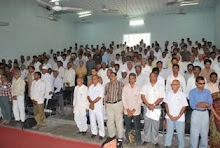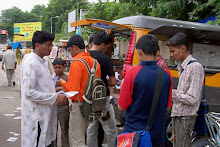The
Asian Age: New Delhi: Wednesday, 05 November 2014.
Ever since it
was introduced in 2005 to ensure transparency, the legislation has left
activists at the mercy of government servants who want to protect their turf .
Recently, the
Central Information Commission (CIC) gave a miss to the Right to Information
(RTI) Act’s 10th anniversary celebrations. The reason: The Modi government
forgot to app-oint a Chief Information Commissioner. So even as the government
promises good governance, transparency is given the go-by. And this is not just
at the Centre, but in states too, where efforts are being made to weaken the
law.
The RTI was
the strongest weapon available to the people to make the bureaucracy and
politicians accountable. But, the attitude of governments and bureaucrats
towards those seeking information has made these individuals prone to several
risks.
EMPTY
WORDS?
Anupama Jha,
regional consultant of Trace International, and former executive director,
Transparency International India, says two anti-corruption bodies in India, the
Central Vigilance Commission and the CIC, are headless. “Prime Minister
Narendra Modi gave a catchy slogan, ‘Make in India’, and invited industrialists
and entrepreneurs from abroad to come and invest here. How will foreign
companies come and invest unless the government ensures good governance through
transparency and makes India corruption-free,” she asks.
Sadly,
information seekers are often at the receiving end of the anger by people in
high places. They are either harassed or killed.
According to
data collected by the Commonwealth Human Rights Initiatives, in the first eight
years of the RTI in India, 42 information seekers were killed and there were
300 cases of them being harassed, attacked and mentally tortured.
Data reveals
that Maharashtra tops among states with the largest number of murders and
attacks, nine and 53 respectively due to RTI. It is followed by Gujarat with
three murders and 34 attacks. In fact, on October 17, 2014, the governor-ruled
Maharashtra issued a directive in the form of a government resolution, asking
all departments and offices not to provide any information under the RTI Act if
it “does not constitute any public interest.”
Interpretation
of maladies
The Right to
Information (RTI) Act is often desc-ribed as a document next only to the
Consti-tution. While the Constitution has had 98 amendments in the last 64
years, the RTI Act has faced more than 100 interpretations by the Supreme Court
and various High Courts.
As per
statistics compiled by the Pune-based Yashwantrao Chavan Academy of
Develo-pment Administration, while the apex court has so far passed 16 orders
in connection with the RTI, the Allahabad High Court has passed three; Andhra
Pradesh HC, five; Delhi HC, 29; Gujarat HC, four; HP HC, one; Jharkhand HC,
two; Kerala HC, six; Kolkata HC, four; Mumbai HC, 22; Punjab and Haryana HC,
21; Madras HC, 10; Goa HC, two and Karnataka HC, two.
The Supreme
Court too has withdrawn certain contentious orders. Take the famous Namit
Sharma Vs Union of India case in early 2013. Here, a two-member SC bench ruled
that Central Information Commis-sions as well as state information commissions
(SICs) should be headed by retired or serving judges.
This led to
many SICs suspending all hearings sine die. This ruling was next to impossible
to implement, but many also felt that the judiciary was trying to enter into
the territory of Parliament.
The
government and civil society challenged this order, leading to the Supreme
Court withdrawing it, admitting a “mistake of law.”
The bench
also concluded it was ultimately “for the Parliament to consider” whether an
appointment required judicial experience or not. On the other hand, another SC
order was used by many information commissioners and public information
officers as an excuse to delay or deny information.
In the famous
CBSE Vs Aditya Bandop-adhyay case (9.8.2011), the apex court ruled, “The nation
doesn’t want a scenario where 75 per cent of the staff of public authorities
spends 75 per cent of the time in collecting and furnishing information to
applicant instead of discharge their duties.”
Government
officials excuse themselves saying they have to prevent people from misusing
the RTI Act. However, activists view this as an attempt to weaken the RTI Act.
Six RTI activists have lost their lives in Bihar from 2008 and 2013. Ten
attacks were reported in eight years in Uttar Pradesh, An-dhra Pradesh, Delhi,
Karnataka and Haryana.
The attempt
to curb the use of RTI has become so bad, says Shiv Prakash Rai, 56, of Nagrik
Adhikar Manch, that people are simply not asking for information, fearing for
their lives. Mr Rai was jailed for 29 days in 2008 for exposing the solar
lights scam in Bihar’s Buxar region.
Incidentally,
the RTI was the result of a prolonged struggle by the people at the grassroots
level. It was finally born as part of the Fundament Rights in 2005; Parliament
enacted the law on October 2005. But what started with great promise has
floundered due to multifarious reasons.
SHAKE THE
SYSTEM
Activist
Dhananjay Jha who hails from Goraul, in Bihar’s Vaishali district, says that
information commissions are filled with retired bureaucrats. He wondered how a
former babu who spent 35 years hiding facts and remaining aloof from public,
could help petitioners get information.
Mr Jha has
also been threatened and his father bashed up for seeking information about
government ration shops. A PDS shopkeeper hired goons and tried to kidnap his
children. Mr Jha then sent his family into hiding. He got some relief only
after the media highlighted his case.
In the
initial years, the RTI was a strong weapon in the hands of people as the CIC
focused its attention on political parties. A full bench of the CIC, headed by
a no-nonsense ex-IAS officer, Satya-nanda Mishra, on June 3, 2013, took a
historic decision by bringing the all-powerful political class under the
purview of the RTI.
When
political parties protested, the then Prime Minister, Dr Manmohan Singh, asked
them to promulgate an ordinance to keep them away from the purview of the RTI
Act. However, it didn’t help.
Parliament,
then, tried to nullify the decision through an amendment, but in the face of
stiff resistance from NGOs and civil society groups, the matter was referred to
a Parliamentary committee.
The full
bench of the CIC, while penning the landmark order said, “We hold that the Congress,
BJP, CPM, CPI, NCP and BSP have been substantially financed by the Central
government under Section 2(h)(ii) of the RTI Act. The criticality of the role
being played by these political parties and the nature of duties performed by
them also point to their public character, bringing them in the ambit of
Section 2(h). The constitutional and legal provisions discussed herein also
point towards their character as public authorities.”
The full
bench observed that political parties were given land worth Rs2,556 crore in
Delhi and free airtime on Doordarshan.
EMBARRASSING
CASES
The reason
for the government wanting to weaken the Act was that it was causing a lot of
embarrassment. Here are some cases: The CIC asked Pratibha Patil, the then
President to declare her assets; the government was forced to disclose the then
finance minister Pranab Mukherjee’s note on the 2G spectrum case, and the
Robert Vadra land deal in Haryana was being questioned through RTI.
The states,
too, were not forthcoming and tried to weaken the law, leading to mounting
cases in commissions. A study by RTI Assessment and Advocacy Group and
Samay-Centre for Equity Studies in collaboration with the National Campaign for
People’s Right to Information, paints an alarming picture of information
commissions across the country. The collective backlog in 23 commissions was
1.98 lakh cases as on December 31, 2013. The maximum number of appeals and
complaints were pending in Uttar Pradesh (48,442), followed by Maharashtra
(32,390) and the Central Information Commission (26,115).
Clearly,
neither the Centre nor states are taking RTI seriously. How about some
transparency here?














































































